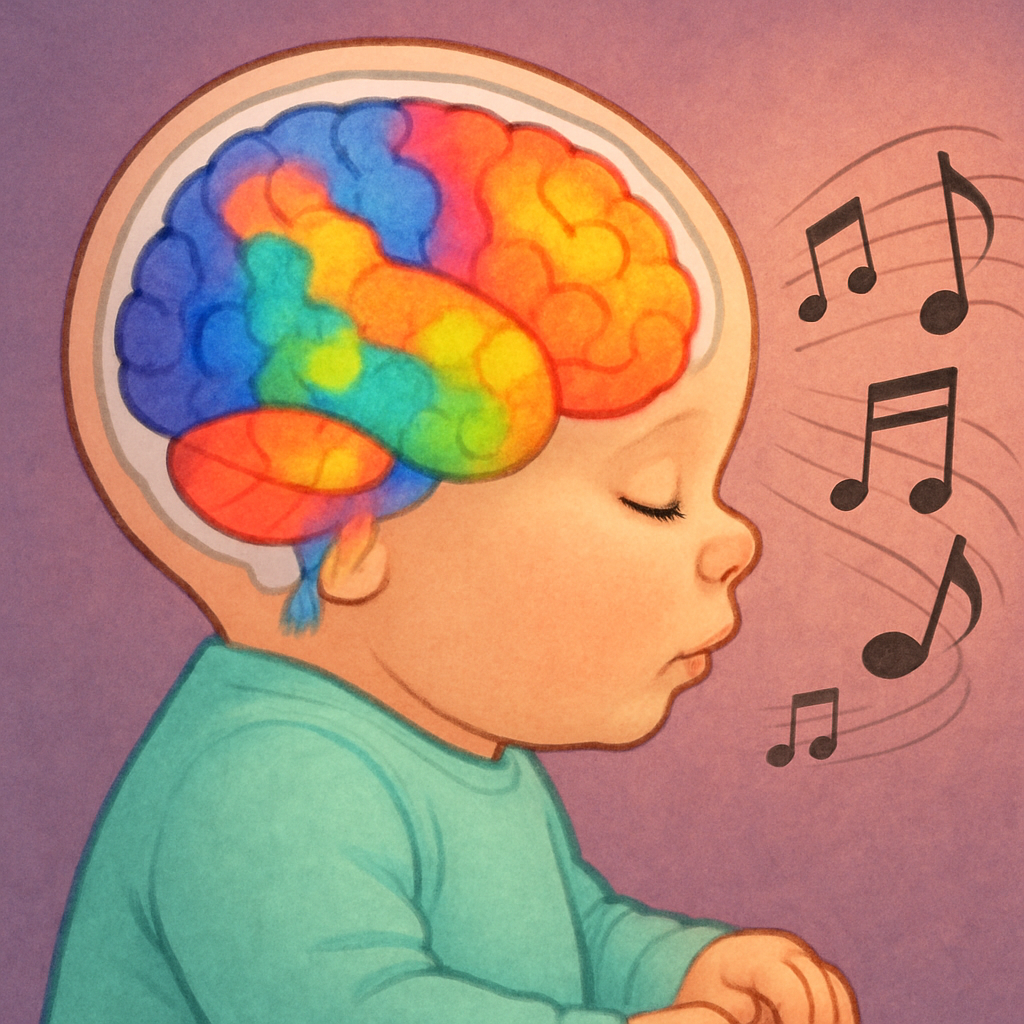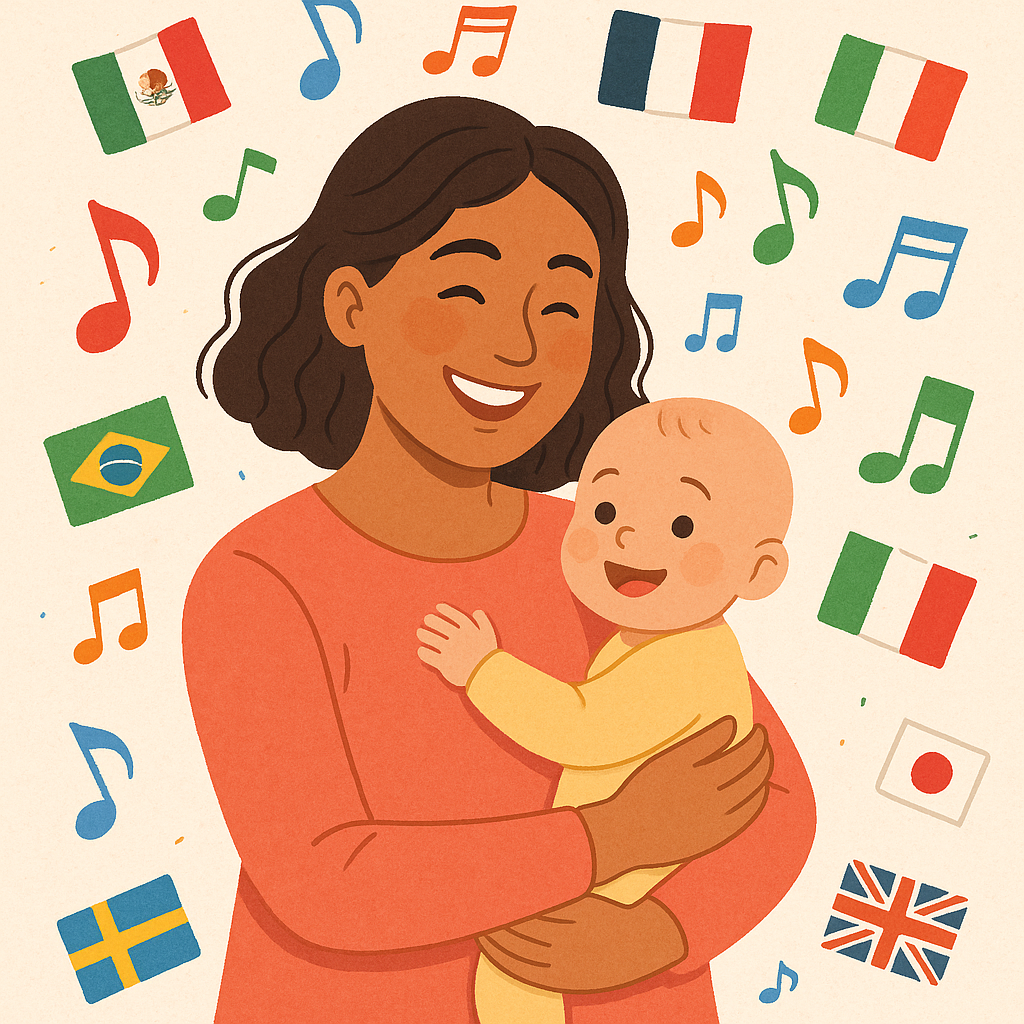When you sing a lullaby or clap to a nursery rhyme, you’re doing more than entertaining your baby—you’re igniting their brain with activity. Music engages multiple brain regions simultaneously, earning it the nickname “whole-brain workout” for infants. Explore music’s brain benefits. Let’s delve into the science of music’s impact on baby brain development, debunks myths like the “Mozart effect,” and offers practical ways to weave music into daily life to foster language, memory, and emotional security.
- How exactly does music light up your baby’s brain?
- When should you start sharing music—and how much is the right amount?
- Does the kind of music matter, or is interaction the secret sauce?
- What are simple ways to weave music into daily routines?
- Which myths and risks should parents watch for?
- Where is the research headed—and how can you stay informed?
- Your Top Questions, Answered
- Final Thoughts
How exactly does music light up your baby’s brain?
Music stimulates a baby’s auditory, motor, language, memory, and emotional circuits all at once. Research shows that musical activities enhance brain connectivity in infants. Learn about music and neuroplasticity. When you sing or dance with your baby:
- The auditory cortex processes pitch and rhythm, sharpening sound recognition.
- Motor and sensory areas coordinate movements like clapping or kicking, building physical skills.
- The hippocampus stores melodies, supporting long-term memory formation.
- The amygdala links soothing tunes to feelings of safety and calm, promoting emotional well-being.
A University of Washington study found that 9-month-olds who participated in 12 rhythmic play classes showed improved ability to distinguish new speech sounds, a critical step toward language development. To amplify these benefits, combine music with sensory activities like texture bins or light shows, as suggested in Sensory Play Ideas.

When should you start sharing music—and how much is the right amount?
You can begin sharing music during the third trimester, as fetuses start responding to sound around 25 weeks gestation. Discover fetal hearing. These early exposures may create lasting memories, measurable up to four months after birth. From birth to age 3, a baby’s brain forms approximately 1 million new synapses per second Understand early brain development, making short, interactive music sessions highly impactful.
Guidelines for Music Exposure:
- Aim for 10–15 minutes of active music (singing, clapping, dancing) 2–3 times daily, which is more effective than constant background music.
- Keep volumes below 50 decibels, akin to soft rainfall, to protect delicate ears, as per American Academy of Pediatrics guidelines.
- Integrate music with activities like tummy time to make them more engaging Tummy Time Benefits.
Watch for signs of overstimulation, such as yawning or turning away, and pause for quiet moments to help your baby process the experience.
Does the kind of music matter, or is interaction the secret sauce?
Interaction is key, not genre. Research suggests that various music genres—classical, jazz, folk, or pop—offer similar developmental benefits when paired with engagement. Focus on these elements:
- Tempo: Songs under 80 beats per minute (BPM) with predictable melodies soothe the nervous system.
- Nursery Rhymes: Songs with hand motions, like “Pat-a-Cake,” enhance phonemic awareness. See Nursery Rhymes).
- Cultural Variety: Rotating tunes from different cultures broadens auditory exposure and cognitive flexibility.
- Live Singing: Your voice, especially when singing live, releases oxytocin, fostering bonding more than recorded music.
Mix genres freely—whether it’s Mozart or Motown—as long as the music is gentle, repetitive, and shared with your baby.

What are simple ways to weave music into daily routines?
Turn everyday moments into brain-boosting musical experiences with these simple ideas:
Morning wake-up: Clap along to a bright marching tune to prime attention and motor skills—perfect alongside Imitation Games.
Diaper changes: “Piggyback” fresh lyrics onto a familiar melody (“This is the way we change your pants…”) to teach word segmentation.
Bedtime: A lullaby around 60–70 BPM can lower cortisol by up to 27 % in preterm infants, easing the path to sleep.
Car rides: Try call-and-response playlists; waiting for your echo builds patience and social timing.
Playtime: Hand your baby a rattle or homemade shaker from DIY Baby Toys to practice cause-and-effect and fine-motor control.
Which myths and risks should parents watch for?
Myth: The “Mozart effect” makes babies smarter. As noted in Debunking the Mozart effect. Focus on interactive music for real developmental gains.
Risks to Watch:
- Loud Volumes above 85 decibels (e.g., concerts) can damage infant hearing. Stick to 50 decibels or lower.
- Constant background music may disrupt naps and language learning; silence is also a developmental tool.
- Screen-based musical shows lack the face-to-face cues that fuel social-emotional growth highlighted in Play vs. TV.
Watch for overstimulation signs—fussiness, arching, averting gaze—and dial the sound down or off.
Where is the research headed—and how can you stay informed?
Long-term, genre-specific effects are still under study. Few randomized trials follow infants into school age, and most focus on Western lullabies. Researchers are now calling for diverse musical samples and longer follow-ups to see if early exposure predicts academic skills.
To stay informed:
- Follow updates from the National Institutes of Health on music and child development.
- Ask your pediatrician about board-certified music therapists if your baby is preterm or has special needs.
- Explore broader enrichment ideas in Boost Your Baby’s Brain Power to complement musical play.
Your Top Questions, Answered
-
Does constant background music help my baby learn faster?
No. Interactive bursts of singing or instrument play outperform 24/7 background noise. Babies need quiet to process new input and to sleep soundly. -
What are the best first songs?
Slow, simple lullabies like “Brahms’ Wiegenlied” or rhythmic rhymes such as “Pat-a-Cake.” Their predictable patterns are easy for newborn brains to absorb. -
Can music therapy aid preemies?
Yes. Live maternal singing in NICUs improved sleep-state regulation by about 30 %. Ask hospital staff about certified music therapists Benefits of maternal singing. -
Is it safe to use infant headphones?
Avoid them. A baby’s skull can amplify volume, and there’s no need for direct-to-ear sound before toddlerhood. -
Will my baby benefit more from classical music?
Not necessarily. Any gentle, repetitive music paired with your smiling face delivers similar neural benefits.
Final Thoughts
Music transforms everyday moments into opportunities for brain growth and bonding. Whether you’re singing during diaper changes, dancing to a nursery rhyme, or humming a lullaby, you’re building the foundation for your baby’s language, learning, and emotional well-being. Embrace these joyful interactions and watch your baby’s brain light up with every note.